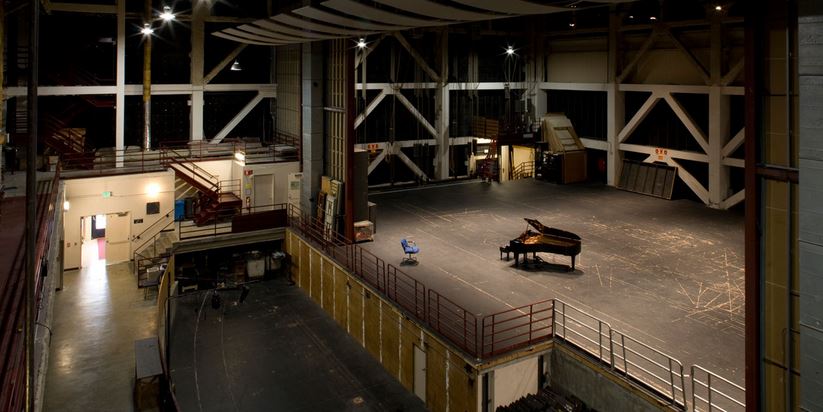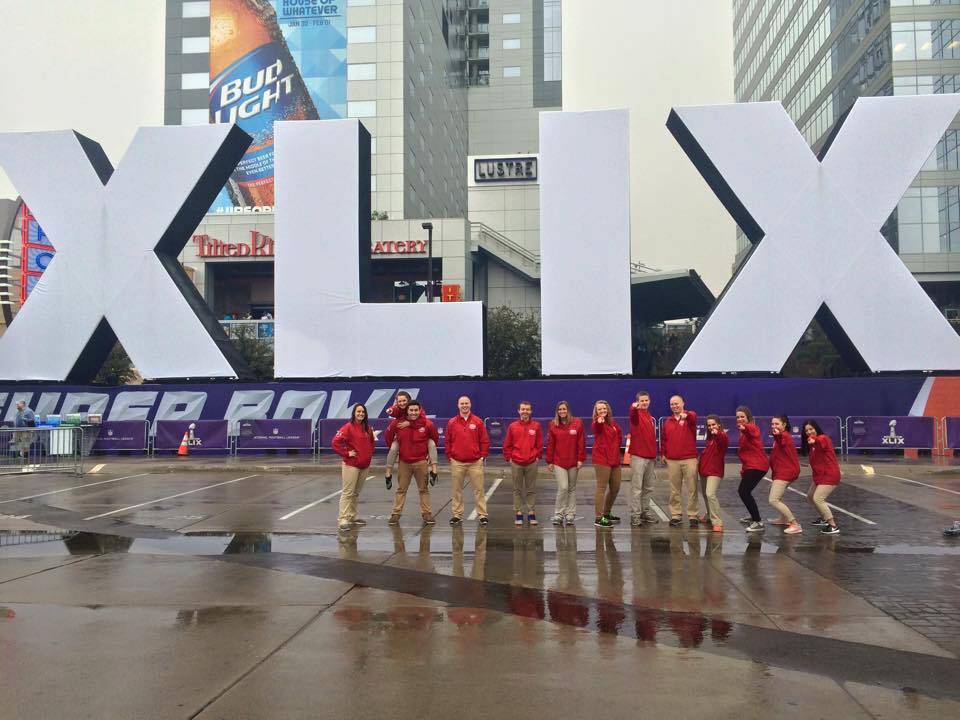The Constellation Sound System at Zellerbach Rehearsal Hall
Attendees at the recent Performing Arts Managers Conference in San Francisco, California, were given a demonstration of the Constellation sound system at the Zellerbach Rehearsal Hall at the San Francisco War Memorial & Performing Arts Center. It was an ear-opening experience, in which sound moved in circles or surrounded the audience like a warm fleece.
We weren’t the only ones impressed with the system. Music critic Alex Ross was, too, and he wrote about it for The New Yorker.
“Its principal purpose is to enable flexibility, so that halls can adapt to the needs of different kinds of event. Cinema needs a dry, echo-free environment, so that words can be understood. Chamber music benefits from crisp sound with resonant warmth. Orchestras are at home in halls with a longer reverberation time—more than two seconds, at the Musikverein. And choruses thrive on the booming acoustic of a cathedral. Constellation replicates this range of reverb times, which vary with the size of the space. One can choose from among different settings: cinema or lecture hall (0.4 seconds); chamber (one second); theatre (1.4 seconds); concert hall (two seconds); and “sacred space” (2.8 seconds). Thus, the system can give bloom to a somewhat dry acoustic, as at Zellerbach Hall, in Berkeley, and it can supply a cleaner sound for amplified jazz and pop, as at Svetlanov Hall, in Moscow.”
Zellerbach Rehearsal Hall is also where the San Francisco Symphony holds its SoundBox events that make use of the Constellation system in an effort to attract a different (and sometimes younger) audience. It appears to be working, as each event has sold out.
Please read The New Yorker article, “Wizards of Sound,” for more about the Constellation sound system.
(h/t: Jennifer Norris. Image: San Francisco War Memorial & Performing Arts Center)
Imagine Sunlight in Your Venue 24 Hours a Day
Now here’s a really cool light technology. It’s recreates how sunlight looks through a skylight, which means you can have sunlight 24 hours a day or deep in the recesses of your venue. An Italian company, CoeLux, developed the product, which won the Lux Awards 2014 Light Source Innovation of the Year.
“The scientists who invented the light figured out how to use a thin coating of nanoparticles to accurately simulate sunlight through Earth’s atmosphere and the effect known as Rayleigh scattering,” Michael Zhang reported for PetaPixel. “It’s not just the color temperature that’s the same—the quality of the light feels the same, as well.”
The company says the technology is ideal for all types of indoor spaces and that future improvements will allow changes to the position of the sun in the frame and the color temperature of the sunlight.
I could imagine, for example, this being implemented in convention centers, especially in meeting spaces. Place a few of these in the ceiling, and it’s like you’re having a meeting outdoors!
Please watch the following video for more information about this technology.
(Image: CoeLux)
IAVM Student Members Experience the Super Bowl
Congratulations to the group of IAVM student members from Missouri State University who worked at the 2015 Super Bowl at the University of Phoenix Stadium.
“Throughout the weekend, students worked mainly in an area called Super Bowl Central,” Melissa Price reported. “They greeted guests as they entered and provided information and directions. They also had the chance to be involved with some of the free concerts and really enjoyed the performance of the Roots from The Tonight Show with Jimmy Fallon.”
Troy Parrott said they split up in pairs and went to different street corners.
“Some of us had to use clickers to keep track of people walking in and out of certain restaurants, because they filled up quickly,” Parrott said. “While the rest of us were handing out maps to fans and mainly directing them to the NFL Fan Experience, bathroom, convention center, etc.”
Working at the Super Bowl is an annual event for the school’s Entertainment Management Association, and Price said this year “the students worked with NFL Fan Experience, the National Football League’s official source for event experiences and hospitality, as well as the Arizona Host Committee.”
Please visit Price’s blog entry to learn more about the students’ experiences, and once again, congratulations on a job well done!
(Image: Missouri State University)
Installing iBeacons in a Building
As iBeacons increase in popularity, venue managers may wonder what it’s like to install them. If so, let me point you in the direction of an informative article from the Brooklyn Museum, which is going through the process of installing 150 iBeacons in its 500,000-square-foot facility. While museums aren’t one of IAVM’s primary venue types, I believe many of you can relate and imagine your own venue when reading this article. For example, there’s the issue of different wall types:
“…we’ve had a lot of problems actually getting these to stay put on the walls. It’s no secret we have a tough production environment here; we use different types of paint (gloss, flat, semi) and our walls vary in surface (plaster, glass, sheetrock, cement). No matter what we do, we’ve found beacons are constantly falling off walls…constantly.”
Then there’s signal strength inside a building:
“Beacon signal, for instance, is disrupted by everything save air…walls, vitrines, objects, people, you name it. This problem is so bad, in fact, that I can be standing directly beside a beacon on the wall, and will find a stronger signal coming from one across the room.”
As I mentioned, “The Realities of Installing iBeacon to Scale” is an informative article and presents some first-hand experiences you should consider if you go down the iBeacon path.
(photo credit: Media Hack Days 2014 via photopin cc)
Pouring Your Own Beer
WTAE in Pittsburgh recently posted a story about DraftServ, which is product that lets fans pour their own beers. If you haven’t heard of it yet, I bet you have some questions, such as how to monitor under-age drinking. The video above answers many of those questions.
Do you want to receive a Front Row News weekly digest?
Categories
- Allied (861)
- Architecture (147)
- Arenas (750)
- Career (897)
- Convention Centers (897)
- Education (623)
- Events (1,544)
- Food & Beverage (193)
- Foundation (113)
- Guest Experience (1,497)
- Industry News (2,270)
- Leadership (1,888)
- Marketing (150)
- Membership (2,001)
- Music (213)
- Performing Arts Centers (456)
- Professional Development (409)
- Research (128)
- Safety & Security (442)
- Sports (764)
- Stadiums (611)
- Student (159)
- Technology (516)
- Ticketing (92)
- Touring (82)
- Trends (365)
- Uncategorized (692)
- Universities (218)
- Video (25)
- Young Professional (198)
Twitter Feed
- Twitter feed loading
Recent Posts
- Welcome to Our Newest Members
- Register Today for the 2025 AIPC/CCC/IAVM Academy
- The Raleigh Convention Center Announces New Director of Marketing and Sponsorships
- Texas FFA Awards Fort Worth Hospitality Team with Honorary Lonestar Degrees
- VenuWorks Diversifies Portfolio to Include More Amateur Sports Complexes
Categories
- Allied
- Architecture
- Arenas
- Career
- Convention Centers
- Education
- Events
- Food & Beverage
- Foundation
- Guest Experience
- Industry News
- Leadership
- Marketing
- Membership
- Music
- Performing Arts Centers
- Professional Development
- Research
- Safety & Security
- Sports
- Stadiums
- Student
- Technology
- Ticketing
- Touring
- Trends
- Uncategorized
- Universities
- Video
- Young Professional
Archives
- August 2025
- July 2025
- June 2025
- May 2025
- April 2025
- March 2025
- February 2025
- January 2025
- December 2024
- November 2024
- October 2024
- September 2024
- August 2024
- July 2024
- June 2024
- May 2024
- April 2024
- March 2024
- February 2024
- January 2024
- December 2023
- November 2023
- October 2023
- September 2023
- August 2023
- July 2023
- June 2023
- May 2023
- April 2023
- March 2023
- February 2023
- January 2023
- December 2022
- November 2022
- October 2022
- September 2022
- August 2022
- July 2022
- June 2022
- May 2022
- April 2022
- March 2022
- February 2022
- January 2022
- December 2021
- November 2021
- October 2021
- September 2021
- August 2021
- July 2021
- June 2021
- May 2021
- April 2021
- March 2021
- February 2021
- January 2021
- December 2020
- November 2020
- October 2020
- September 2020
- August 2020
- July 2020
- June 2020
- May 2020
- April 2020
- March 2020
- February 2020
- January 2020
- December 2019
- November 2019
- October 2019
- September 2019
- August 2019
- July 2019
- June 2019
- May 2019
- April 2019
- March 2019
- February 2019
- January 2019
- December 2018
- November 2018
- October 2018
- September 2018
- August 2018
- July 2018
- June 2018
- May 2018
- April 2018
- March 2018
- February 2018
- January 2018
- December 2017
- November 2017
- October 2017
- September 2017
- August 2017
- July 2017
- June 2017
- May 2017
- April 2017
- March 2017
- February 2017
- January 2017
- December 2016
- November 2016
- October 2016
- September 2016
- August 2016
- July 2016
- June 2016
- May 2016
- April 2016
- March 2016
- February 2016
- January 2016
- December 2015
- November 2015
- October 2015
- September 2015
- August 2015
- July 2015
- June 2015
- May 2015
- April 2015
- March 2015
- February 2015
- January 2015
- December 2014
- November 2014
- October 2014
- September 2014
- August 2014
- July 2014
- June 2014
- May 2014
- April 2014
- March 2014
- February 2014
- January 2014
- December 2013
- November 2013
- October 2013
- September 2013
- August 2013
- July 2013
- June 2013
- May 2013
- April 2013
- March 2013
- February 2013
- January 2013
- May 2012
- March 2012
- December 2011
- November 2011
- October 2011
Recent Comments
- Frank Bradshaw, Ph.D., CVE on John Meyer, CVE, a Tireless Advocate of Certification for Venue Professionals, Has Died
- Neil Sulkes on Hilary Hartung, Friend to Many in Venue Marketing, Has Left Us
- Jason Parker, CVE on The Devastation of Hurricane Helene and How We Can Support One Another
- Larry Perkins on Touhey Testifies Against Speculative Ticketing Before Congressional Subcommittee
- Peter Secord on Major Players for Planned Elkhart Amphitheater Were in the Mix at VenueConnect



